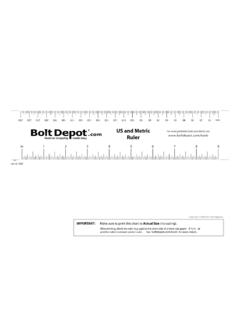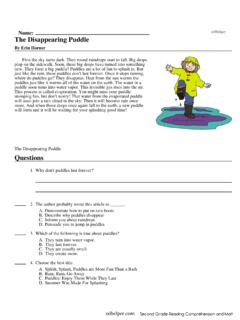Transcription of PROBLEMS IN PLANE AND SOLID GEOMETRY v.1 Plane …
1 PROBLEMS IN PLANE AND PLANE GeometryViktor Prasolovtranslated and edited by Dimitry book has no equal. The priceless treasures of elementary GEOMETRY arenowhere else exposed in so complete and at the same time transparent form. The shortsolutions take barely 2 times more space than the formulations, while still remainingcomplete, with no gaps whatsoever, although many of the PROBLEMS are quite difficult. Onlythis enabled the author to squeeze about 2000 PROBLEMS on PLANE GEOMETRY in the book ofvolume of ca 600 pages thus embracing practically all the known PROBLEMS and theoremsofelementary book contains non-standard geometric PROBLEMS of a level higher than that of theproblems usually offered at high school. The collection consists of two parts. Itis based onthree Russian editions of Prasolov s books on PLANE text is considerably modified for the English edition. Many new PROBLEMS are addedand detailed structuring in accordance with the methods of solution is book is addressed to high school students, teachers of mathematics, mathematicalclubs, and college s preface11 From the Author s preface12 Chapter 1.
2 SIMILAR TRIANGLES15 Background15 Introductory problems15 1. Line segments intercepted by parallel lines15 2. The ratio of sides of similar triangles17 3. The ratio of the areas of similar triangles18 4. Auxiliary equal triangles18* * *19 5. The triangle determined by the bases of the heights19 6. Similar figures20 PROBLEMS for independent study20 Solutions21 CHAPTER 2. INSCRIBED ANGLES33 Background33 Introductory problems33 1. Angles that subtend equal arcs34 2. The value of an angle between two chords35 3. The angle between a tangent and a chord35 4. Relations between the values of an angle and the lengths ofthe arc and chordassociated with the angle36 5. Four points on one circle36 6. The inscribed angle and similar triangles37 7. The bisector divides an arc in halves38 8. An inscribed quadrilateral with perpendicular diagonals39 9. Three circumscribed circles intersect at one point39 10. Michel s point40 11. Miscellaneous problems40 PROBLEMS for independent study41 Solutions41 CHAPTER 3.
3 CIRCLES57 Background57 Introductory problems58 1. The tangents to circles58 2. The product of the lengths of a chord s segments59 3. Tangent circles59 4. Three circles of the same radius60 5. Two tangents drawn from one point6134 CONTENTS 61 6. Application of the theorem on triangle s heights61 7. Areas of curvilinear figures62 8. Circles inscribed in a disc segment62 9. Miscellaneous problems63 10. The radical axis63 PROBLEMS for independent study65 Solutions65 CHAPTER 4. AREA79 Background79 Introductory problems79 1. A median divides the triangleinto triangles of equal areas79 2. Calculation of areas80 3. The areas of the triangles into whicha quadrilateral is divided81 4. The areas of the parts into whicha quadrilateral is divided81 5. Miscellaneous problems82* * *82 6. Lines and curves that divide figuresinto parts of equal area83 7. Formulas for the area of a quadrilateral83 8. An auxiliary area84 9. Regrouping areas85 PROBLEMS for independent study86 Solutions86 CHAPTER 5.
4 TRIANGLES99 Background99 Introductory problems991. The inscribed and the circumscribed circles100* * *100* * *100 2. Right triangles101 3. The equilateral triangles101* * *101 4. Triangles with angles of 60 and 120 102 5. Integer triangles102 6. Miscellaneous problems103 7. Menelaus s theorem104* * *105 8. Ceva s theorem106 9. Simson s line107 10. The pedal triangle108 11. Euler s line and the circle of nine points109 12. Brokar s points110 13. Lemoine s point111 CONTENTS5* * *111 PROBLEMS for independent study112 Solutions112 Chapter 6. POLYGONS137 Background137 Introductory problems137 1. The inscribed and circumscribed quadrilaterals137* * *138* * *138 2. Quadrilaterals139 3. Ptolemy s theorem140 4. Pentagons141 5. Hexagons141 6. Regular polygons142* * *142* * *143 7. The inscribed and circumscribed polygons144* * *144 8. Arbitrary convex polygons144 9. Pascal s theorem145 PROBLEMS for independent study145 Solutions146 Chapter 7. LOCI169 Background169 Introductory problems169 1.
5 The locus is a line or a segment of a line169* * *170 2. The locus is a circle or an arc of a circle170* * *170 3. The inscribed angle171 4. Auxiliary equal triangles171 5. The homothety171 6. A method of loci171 7. The locus with a nonzero area172 8. Carnot s theorem172 9. Fermat-Apollonius s circle173 PROBLEMS for independent study173 Solutions174 Chapter 8. CONSTRUCTIONS183 1. The method of loci183 2. The inscribed angle183 3. Similar triangles and a homothety183 4. Construction of triangles from various elements183 5. Construction of triangles given various points184 6. Triangles184 7. Quadrilaterals185 8. Circles1856 CONTENTS 9. Apollonius circle186 10. Miscellaneous problems186 11. Unusual constructions186 12. Construction with a ruler only186 13. Constructions with the help of a two-sided ruler187 14. Constructions using a right angle188 PROBLEMS for independent study188 Solutions189 Chapter 9. GEOMETRIC INEQUALITIES205 Background205 Introductory problems205 1.
6 A median of a triangle205 2. Algebraic PROBLEMS on the triangle inequality206 3. The sum of the lengths of quadrilateral s diagonals206 4. Miscellaneous PROBLEMS on the triangle inequality207* * *207 5. The area of a triangle does not exceed a half product of two sides207 6. Inequalities of areas208 7. Area. One figure lies inside another209* * *209 8. Broken lines inside a square209 9. The quadrilateral210 10. Polygons210* * *211 11. Miscellaneous problems211* * *211 PROBLEMS for independent study212 Supplement. Certain inequalities212 Solutions213 Chapter 10. INEQUALITIES BETWEEN THE ELEMENTS OF A TRIANGLE235 1. Medians235 2. Heights235 3. The bisectors235 4. The lengths of sides236 5. The radii of the circumscribed, inscribed and escribed circles236 6. Symmetric inequalities between the angles of a triangle236 7. Inequalities between the angles of a triangle237 8. Inequalities for the area of a triangle237* * *238 9. The greater angle subtends the longer side238 10.
7 Any segment inside a triangle is shorter than the longest side238 11. Inequalities for right triangles238 12. Inequalities for acute triangles239 13. Inequalities in triangles239 PROBLEMS for independent study240 Solutions240 Chapter 11. PROBLEMS ON MAXIMUM AND MINIMUM255 CONTENTS7 Background255 Introductory problems255 1. The triangle255* * *256 2. Extremal points of a triangle256 3. The angle257 4. The quadrilateral257 5. Polygons257 6. Miscellaneous problems258 7. The extremal properties of regular polygons258 PROBLEMS for independent study258 Solutions259 Chapter 12. CALCULATIONS AND METRIC RELATIONS271 Introductory problems271 1. The law of sines271 2. The law of cosines272 3. The inscribed, the circumscribed and escribed circles; theirradii272 4. The lengths of the sides, heights, bisectors273 5. The sines and cosines of a triangle s angles273 6. The tangents and cotangents of a triangle s angles274 7. Calculation of angles274* * *274 8. The circles275* * *275 9.
8 Miscellaneous problems275 10. The method of coordinates276 PROBLEMS for independent study277 Solutions277 Chapter 13. VECTORS289 Background289 Introductory problems289 1. Vectors formed by polygons (?) sides290 2. Inner product. Relations290 3. Inequalities291 4. Sums of vectors292 5. Auxiliary projections292 6. The method of averaging293 7. Pseudoinner product293 PROBLEMS for independent study294 Solutions295 Chapter 14. THE CENTER OF MASS307 Background307 1. Main properties of the center of mass307 2. A theorem on mass regroupping308 3. The moment of inertia309 4. Miscellaneous problems310 5. The barycentric coordinates3108 CONTENTSS olutions311 Chapter 15. PARALLEL TRANSLATIONS319 Background319 Introductory problems319 1. Solving PROBLEMS with the aid of parallel translations319 2. PROBLEMS on construction and loci320* * *320 PROBLEMS for independent study320 Solutions320 Chapter 16. CENTRAL SYMMETRY327 Background327 Introductory problems327 1. Solving PROBLEMS with the help of a symmetry327 2.
9 Properties of the symmetry328 3. Solving PROBLEMS with the help of a symmetry. Constructions328 PROBLEMS for independent study329 Solutions329 Chapter 17. THE SYMMETRY THROUGH A LINE335 Background335 Introductory problems335 1. Solving PROBLEMS with the help of a symmetry335 2. Constructions336* * *336 3. Inequalities and extremals336 4. Compositions of symmetries336 5. Properties of symmetries and axes of symmetries337 6. Chasles s theorem337 PROBLEMS for independent study338 Solutions338 Chapter 18. ROTATIONS345 Background345 Introductory problems345 1. Rotation by 90 345 2. Rotation by 60 346 3. Rotations through arbitrary angles347 4. Compositions of rotations347* * *348* * *348 PROBLEMS for independent study348 Solutions349 Chapter 19. HOMOTHETY AND ROTATIONAL HOMOTHETY359 Background359 Introductory problems359 1. Homothetic polygons359 2. Homothetic circles360 3. Costructions and loci360 CONTENTS9* * *361 4. Composition of homotheties361 5. Rotational homothety361* * *362* * *362 6.
10 The center of a rotational homothety362 7. The similarity circle of three figures363 PROBLEMS for independent study364 Solutions364 Chapter 20. THE PRINCIPLE OF AN EXTREMAL ELEMENT375 Background375 1. The least and the greatest angles375 2. The least and the greatest distances376 3. The least and the greatest areas376 4. The greatest triangle376 5. The convex hull and the base lines376 6. Miscellaneous problems378 Solutions378 Chapter 21. DIRICHLET S PRINCIPLE385 Background385 1. The case when there are finitely many points, lines, 2. Angles and lengths386 3. Area387 Solutions387 Chapter 22. CONVEX AND NONCONVEX POLYGONS397 Background397 1. Convex polygons397* * *397 2. Helly s theorem398 3. Non-convex polygons398 Solutions399 Chapter 23. DIVISIBILITY, INVARIANTS, COLORINGS409 Background409 1. Even and odd409 2. Divisibility410 3. Invariants410 4. Auxiliary colorings411 5. More auxiliary colorings412* * *412 6. PROBLEMS on colorings412* * *413 Solutions413 Chapter 24.






